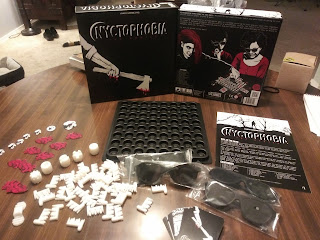Today's entry is the first in a series. This is the 'How to GM' series that I wrote for PinkFae. This particular article was published on 19 June 2016.
I'm going to do something a little different. Today's post will be the first in a series, which will run until I'm done. How many posts will there be in this series? I don't know. I'm making this up as I go. 😊 But this series of posts will be an analysis of GMing. How to do it, how to get players, how to prepare, how to be good at it... that's what we will look at in this series. The series won't be consecutive; I'll intersperse it with my other articles. But for today, we'll start with How to Choose a Game System.
24 November 2018
17 November 2018
Board Game Review: Jorvik
For a few years, the Dork Spouse and I lived in the city of York in the United Kingdom. I very much miss living there; that city is (in my opinion) the most beautiful city in the world. It has an ancient history; it was originally founded in 72 CE as a military outpost by the Roman Empire. It grew to an important trading centre, and when the Romans withdrew from the area in 410 CE, the city (known at that time as Eboracum) was claimed by the Anglo-Saxons, who renamed it Eaforwic. During the Scandinavian invasions, it became a vital holding in the Norsemen's territory. The name was corrupted into their tongue as Jorvik. Following the Norman invasion, the city came to be the second most important city in all of England, with the name being further corrupted into York.
Given that I am so fond of the city and its history and heritage, when I discovered that there was a game based on the Viking era of the city's past, I knew I had to have a copy. And now I am going to review that game for you. This is my review of Jórvík, by Stefan Feld, published by Eggertspiele and Stronghold Games.
Let's start off by looking at the numbers:
Given that I am so fond of the city and its history and heritage, when I discovered that there was a game based on the Viking era of the city's past, I knew I had to have a copy. And now I am going to review that game for you. This is my review of Jórvík, by Stefan Feld, published by Eggertspiele and Stronghold Games.
Let's start off by looking at the numbers:
10 November 2018
PinkFae Archive #21: Creativity: The Driving Force in Games?
Today, we come to the reposting of the PinkFae article that I originally wrote and published on 12 June 2016.
This is in part because ideas don't spring fully formed into a creative person's head. They are reworkings of things these people have seen or heard or felt or experienced. As a friend of mine is fond of saying, 'Good artists borrow. Great artists steal!' Which is a valid, if somewhat flippant, way of saying that consuming the creative works of others is the essential fuel for one's own creativity.
03 November 2018
Board Game Review: Nyctophobia
A few months back, I learned about a fascinating new concept for a board game. The idea came from a woman who was trying to play games with her uncle, who happened to be visually impaired. She found herself wishing that more games were playable based on tactile sensory input rather than visual. This inspired her to design a game in which players cannot see, and must feel the board in order to take their actions. Thus, Nyctophobia (from Pandasaurus Games) was born.
Apparently, Target wanted an exclusive edition of the game, so if you buy a copy in one of their stores, you get the Vampire Encounter edition, which has some different art and slightly altered mechanics. In reading the forums on Board Game Geek, it would seem that Target's desire for a different version also stemmed from an interest in having a slightly less stalker-y game, and they felt that vampires were a little less terrifying and gruesome than an axe murderer.
Apparently, Target wanted an exclusive edition of the game, so if you buy a copy in one of their stores, you get the Vampire Encounter edition, which has some different art and slightly altered mechanics. In reading the forums on Board Game Geek, it would seem that Target's desire for a different version also stemmed from an interest in having a slightly less stalker-y game, and they felt that vampires were a little less terrifying and gruesome than an axe murderer.
Subscribe to:
Posts (Atom)







